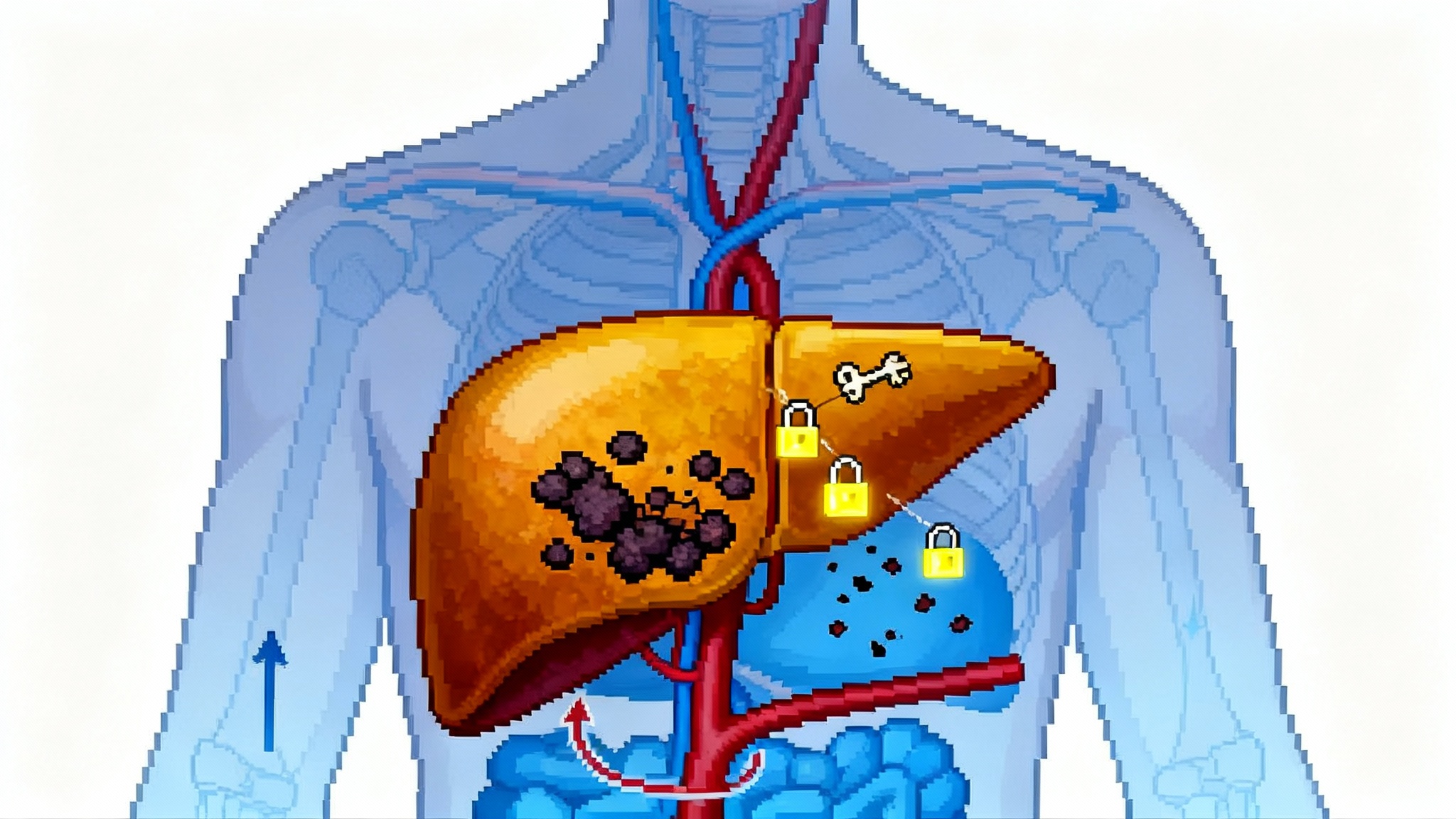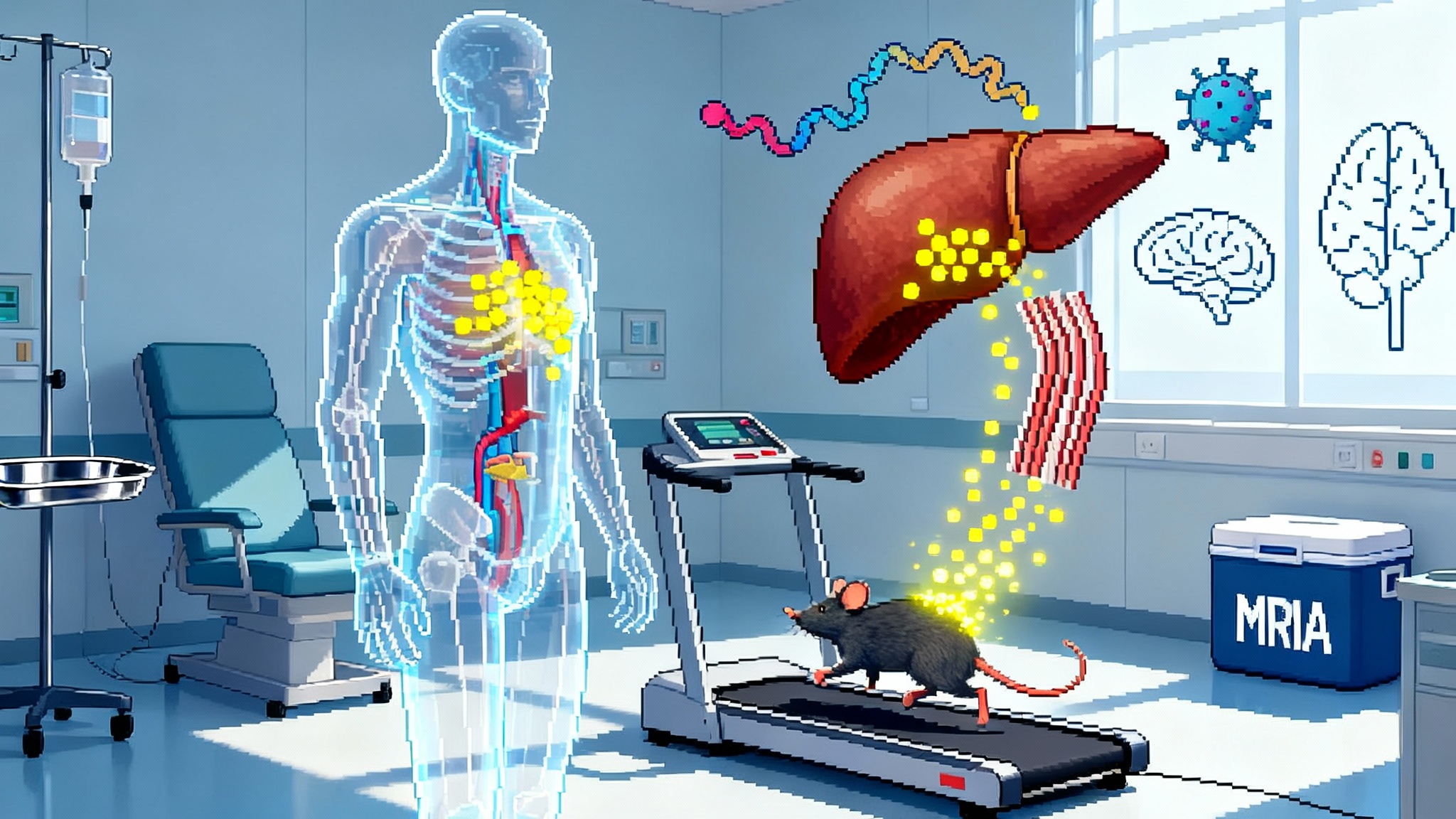Senolytics 2.0: Liver‑tropic PROTACs curb MASLD and cancer
New 2025 preclinical data on 753b, a liver-targeted PROTAC that degrades BCL-xL/BCL-2, selectively clears senescent cells, slows MASLD, dampens fibrosis signals, and lowers liver cancer risk in mice. Here is what platelet-sparing, organ-focused senolytics mean for first-in-human trials.

Breaking news in longevity: a senolytic that prefers the liver
A new study released in March 2025 reports that a dual BCL-xL and BCL-2 degrader, known as 753b, acts as a potent senolytic that concentrates in the liver, clears senescent cells, slows metabolic dysfunction-associated steatotic liver disease, and reduces hepatocellular carcinoma in mouse models. The researchers describe selective reduction of senescent cells in aged and MASH-like livers, alongside blunted progression to liver cancer even when fibrosis was already present. The mechanistic and disease-modifying signal makes this one of the most consequential preclinical senolytic readouts to date; see the Nature Aging liver senolytic study.
If these findings translate, liver-tropic senolytics could become an entirely new pillar next to thyroid hormone receptor-beta agonists and glucagon-like peptide-1 agents in the emerging treatment stack for metabolic liver disease. More importantly, the 753b data reopen a question that many in longevity research have wrestled with for a decade: can we clear senescent cells safely, in the right organ, at the right time, and achieve durable disease modification without collateral damage?
Why senescent cells matter in fatty liver disease
Metabolic dysfunction-associated steatotic liver disease, the new umbrella term that replaces nonalcoholic fatty liver disease, spans a spectrum from simple fat overload to metabolic dysfunction-associated steatohepatitis with fibrosis. Across that spectrum, hepatocytes and non-parenchymal cells can enter a state of cellular senescence. Senescent cells stop dividing yet remain metabolically active. They secrete a mix of inflammatory and fibrogenic factors called the senescence-associated secretory phenotype. Think of them as smoke alarms that never switch off and keep summoning emergency crews, even after the fire is out. Over time, that steady alarm call recruits immune cells, activates stellate cells that lay down scar tissue, and stresses the surrounding tissue microenvironment.
Multiple lines of evidence tie senescence to liver inflammation, fibrogenesis, and cancer initiation. Senescent hepatocytes can push neighbors toward dysfunction through paracrine signals. Senescent stellate cells resist normal clearance and sustain a wound-healing program. Senescent immune cells become poor at surveillance. In short, senescence is not just a passive mark of damage. It can be a driver of the disease engine.
From blunt tools to smart degraders
First-generation senolytics taught an uncomfortable lesson. Small-molecule inhibitors such as navitoclax could trigger apoptosis in senescent cells by disabling the anti-apoptotic proteins they rely on. But navitoclax hit platelets through BCL-xL and often caused dose-limiting thrombocytopenia. Researchers then turned to proteolysis targeting chimeras, or PROTACs. These are two-headed small molecules: one head binds the target protein, the other recruits an E3 ligase that tags the target for destruction by the proteasome. You are not just blocking a protein. You are removing it from the cell.
The clever twist that sets 753b apart is twofold. First, it is dual, so it drags both BCL-xL and BCL-2 to an E3 ligase and drives their degradation. Senescent cells often rely on multiple anti-apoptotic family members. Hitting both raises the odds of a clean senolytic sweep. Second, it appears platelet-sparing. Platelets lack the von Hippel-Lindau E3 ligase that 753b recruits, which means the degrader has little on-target effect in platelets compared with navitoclax. That principle was documented earlier in leukemia and small-cell lung cancer models, where 753b degraded both BCL-xL and BCL-2 while minimizing thrombocytopenia; see the Haematologica 2023 dual degrader study.
The 2025 liver study adds a third differentiator. 753b shows liver tropism. The compound tends to concentrate in hepatic tissue, which increases senolysis where you want it and reduces exposure elsewhere. The authors partly attribute this to physicochemical properties that favor hepatic sequestration. Others in the field are exploring conjugation strategies such as attaching N-acetylgalactosamine to engage the asialoglycoprotein receptor on hepatocytes. PROTAC chemistry is flexible enough to support both approaches.
What a first-in-human program should look like
The right early clinical plan has to respect three facts. First, BCL-2 family modulation can touch blood lineages, even with platelet-sparing design. Second, senescence has context-dependent tumor-suppressive roles in early lesions, so timing and patient selection matter. Third, liver disease offers excellent noninvasive readouts to track target engagement and disease modification.
Here is a pragmatic path for an initial program:
-
Indication and population
- Adults with noncirrhotic MASH and fibrosis stages F2 to F3. This group has a meaningful near-term risk of progression but enough reserve to tolerate experimental therapy. Exclude decompensated cirrhosis and active malignancy. Enrich for patients with quantitative evidence of senescence signaling to test mechanism.
-
Design
- Phase 1b dose-escalation followed by an expansion cohort. Start with once weekly or every two weeks dosing guided by preclinical pharmacokinetics and safety margins. Include an optional paired biopsy at baseline and 12 to 16 weeks in the expansion arm, with patient-centric support to reduce dropout.
-
Pharmacokinetics and biodistribution
- Serial plasma sampling with population pharmacokinetic modeling. If available, leverage labeled microdose imaging or quantitative whole-body physiologically based pharmacokinetic modeling to infer hepatic accumulation. Early human data confirming liver enrichment would be a major risk reducer for later trials.
-
Pharmacodynamics and senescence biomarkers
- Tissue level: quantify p16 and p21 expression, senescence-associated beta galactosidase staining by digital pathology, and a senescence-associated secretory phenotype panel in biopsy homogenates. Add single-nucleus RNA sequencing on a subset to map which cell types are affected, especially stellate cells and hepatocytes.
- Blood level: track a predefined panel that could include IL-6, osteopontin, matrix metalloproteinases, growth differentiation factor 15, and circulating cytokeratin 18 fragments. Build a composite senescence inflammation score that can be validated against tissue change.
- Exploratory: circulating cell-free DNA methylation signatures associated with senescence and liver injury. As regulators reopen to clocks, see how aging clocks return to the clinic can inform assay design.
-
Liver disease endpoints
- Short term at 12 to 16 weeks: change in magnetic resonance proton density fat fraction, corrected T1 mapping, and magnetic resonance elastography for stiffness. Combine these with the Enhanced Liver Fibrosis panel and pro-collagen markers such as PRO-C3.
- Histology at 48 to 72 weeks: resolution of MASH without worsening fibrosis and at least one stage fibrosis improvement without worsening steatohepatitis. Use blinded central reads and digital morphometry for collagen proportionate area as a continuous variable. That reduces statistical noise and helps in dose finding.
-
Cancer risk endpoints
- While hepatocellular carcinoma incidence is a long-horizon outcome, you can track intermediate risk signals. Monitor alpha-fetoprotein, order ultrasound every 6 months, and add cell-free DNA assays for common liver cancer mutations where local regulations allow. If senolysis truly reduces microenvironmental drivers of carcinogenesis, you should see a favorable drift in these surveillance markers over 12 to 24 months.
-
Patient-reported outcomes and function
- Fatigue scores and performance measures such as six-minute walk distance can capture real-world benefit. Many patients with MASH describe a fatigue that maps to chronic inflammatory signaling. If senolysis works, these scores should move in the right direction.
Safety watch-outs and how to de-risk them
-
Platelets and neutrophils
- Even though platelets lack the von Hippel-Lindau ligase used by 753b, real human data are still needed. Check platelet counts weekly during dose escalation. Because BCL-2 contributes to survival of some hematopoietic cells, track absolute neutrophil counts and lymphocyte subsets.
-
Liver safety
- Watch alanine aminotransferase, aspartate aminotransferase, bilirubin, and international normalized ratio. Senolysis in a fibrotic organ can transiently release enzymes. Predefine rules for dose interruption versus discontinuation. Pair safety labs with symptom diaries and imaging to differentiate expected on-mechanism flares from true toxicity.
-
Tumor biology
- Early senescence can suppress tumor formation by freezing damaged cells in place. That is one reason aggressive senolysis in premalignant settings should be avoided until we have more human data. In MASH with established fibrosis, the balance likely favors removing senescent cells that drive inflammation and scarring. Still, retain standard hepatocellular carcinoma surveillance and exclude patients with high-grade dysplasia at baseline.
-
Drug interactions
- Many metabolic liver disease patients take statins, glucose-lowering agents, and antihypertensives. The chemistry team should design away from cytochrome P450 3A hot spots and transporter liabilities where possible. The clinical team should include a dedicated drug interaction sub-study early.
What makes 753b organ-targeted
Liver tropism can emerge in two ways. A molecule may passively enrich in the liver because of its size, polarity, and binding partners. Or it can be actively targeted. Conjugating to N-acetylgalactosamine to engage the asialoglycoprotein receptor on hepatocytes is a proven strategy in RNA therapeutics and is increasingly explored for small molecules and degraders. A modular PROTAC like 753b gives chemists a dial to tune distribution. Medicinal chemistry can trade on linker length, ring systems that shift polarity, and selective transporter engagement. The goal is a high liver to plasma exposure ratio with minimal accumulation in sensitive off-target tissues such as the heart and bone marrow.
How this fits with today’s treatment stack
The field moved in 2024 when a thyroid hormone receptor-beta agonist gained approval for noncirrhotic MASH with fibrosis. That green light set expectations for endpoints and noninvasive monitoring that a senolytic program can adopt. In parallel, GLP-1 reshapes weight and glycemic control in a broad swath of patients at cardiometabolic risk. A liver-tropic senolytic would not replace these. It would complement them.
Here is a plausible sequencing strategy. Start with lifestyle counseling and metabolic control. Use a thyroid hormone receptor-beta agonist to reduce liver fat and ease inflammation. Layer a senolytic degrader in patients with a strong senescence signal, especially those with stubborn inflammation and fibrosis despite metabolic improvement. The expectation is additive or even synergistic benefits: less fat, less inflammatory signaling, and real progress against scar tissue. Companies like Madrigal have validated the regulatory path for liver disease outcomes. A senolytic developer can now focus on the unique mechanistic readouts that prove they are doing something qualitatively different. For additional context on systems metabolism, see how cellular energy enters clinical care.
The broader longevity play beyond the liver
If the 753b concept holds, it makes the case for organ-tropic senolysis as a platform. Several age-linked diseases feature focal senescent cell populations that drive pathology. Think of osteoarthritis with senescent chondrocytes and synovial fibroblasts, chronic kidney disease with senescent tubular epithelium, or pulmonary fibrosis with senescent alveolar cells and fibroblasts. The lesson from the liver is not only that senolysis can work. It is that controlling where the drug goes and which E3 ligase it recruits can make it tolerable.
Companies that laid the groundwork deserve mention. AbbVie and Genentech established the clinical value of BCL-2 inhibition with venetoclax. Dialectic Therapeutics advanced a platelet-sparing BCL-xL degrader into the clinic. Unity Biotechnology showed that targeting senescent cell survival pathways can be viable in the eye, where local delivery avoids systemic liabilities. Academic groups at MD Anderson and UT Health San Antonio have pushed the BCL-xL and BCL-2 degrader story forward. The next wave will likely pair organ targeting with cell type targeting. Imagine stellate-cell-directed senolysis in the liver or synovial-specific senolysis in the knee.
Practical steps for teams moving now
-
Build a biomarker spine before first patient in
- Predefine a senescence panel and lock analytical methods. Biomarker indecision is the most common avoidable delay in translational programs.
-
Start a chemistry workstream on conjugation and depot formulations
- Even if 753b itself concentrates in the liver, other senolytics may not. Having an asialoglycoprotein receptor targeting option or a reversible depot formulation creates optionality for dosing intervals and steady exposure.
-
Plan for combination studies
- The regulatory and clinical communities now accept layered therapy in MASH. Design drug interaction plans and dose-finding cohorts with background thyroid hormone receptor-beta agonists or GLP-1 agents from the start.
-
Do the hard safety work upfront
- Recruit hematology advisors with real-world experience in BCL-2 family drugs. Build stopping rules for platelets and neutrophils that reflect their comfort level and patient safety.
-
Keep patients at the center
- Offer home blood draws and flexible biopsy scheduling. Invest in clear explanations of senolysis, including the possibility of short-term symptom flares. Trust is a trial accelerant.
What to watch in the next 12 to 24 months
- Confirmation that liver tropism holds in humans with 753b or similar degraders, ideally with pharmacokinetic evidence of high liver to plasma exposure ratios and acceptable marrow exposure.
- A reproducible blood signature for senescence burden that correlates with tissue change. This would be a multiplier for later phase development and payer discussions.
- Early hints that senolysis favorably shifts surveillance markers for hepatocellular carcinoma in high-risk patients. Even a small signal would be a milestone.
- Clear rules of the road on how to pause or stop senolysis in the event of an incipient infection, given the subtle roles of senescence in immune function.
The bottom line
Senolytics have long promised more than they delivered. The new 753b data change the conversation by adding three elements that practitioners care about: a mechanism that hits two key survival nodes in senescent cells, a design that speares platelets by recruiting an E3 ligase absent in platelets, and a distribution pattern that prefers the liver, the organ that most needs the help in MASLD and MASH. None of this guarantees success in people. It does justify moving from what-ifs to a well-designed first-in-human program that reads out pharmacodynamics early and disease modification over a year.
Longevity therapies will not arrive as magic wands. They will arrive as well-targeted tools that change how one organ ages and heals. Liver-tropic PROTAC senolytics may be the clearest example yet. They pick their battles. They choose their terrain. And if 2025’s preclinical breakthrough translates, they could redefine how we keep one of the body’s busiest organs both resilient and cancer-resistant for longer.








